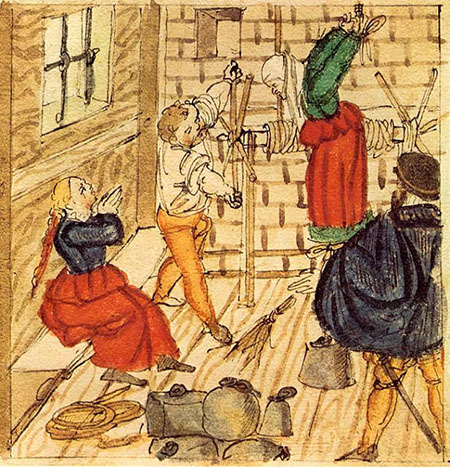 |
1594년, 독일의 뇌르틀링겐 마을. 마리아 홀린이 마녀 누명을 쓰게 됐다. 악인들은 그녀를 참혹하게 고문했다. “마녀임을 자백하라.” 그녀는 거부했다. “나는 마녀가 아니다.”
고문은 11개월동안 이어졌다. 횟수로만 무려 62번. 이는 죽지 않고 살아 돌아온 사람 가운데 최고의 기록으로 알려져 있다.
홀린이 고문으로 깨지고 박살 나 온몸이 너덜너덜해지는 동안 사람들은 의혹을 갖기 시작했다. “그녀는 마녀가 아니었어!” 의혹은 여론이 됐으며, 여론이 부담스러웠던 악인들은 그녀를 석방했다.
홀린 이후 뇌르틀링겐에서는 마녀 사냥이 사라졌다. 훗날 어떤 작가는 그녀에 관한 얘기를 쓰는데, 마지막 문장은 이러했다. “그녀 이후로 마을에서는 히스테리가 중단됐다.”
검찰과 자유한국당은 조국과 그의 가족에 대한 마녀사냥을 중단하라!
검찰과 자유한국당은 조국과 그의 가족에 대한 히스테리를 중단하라!
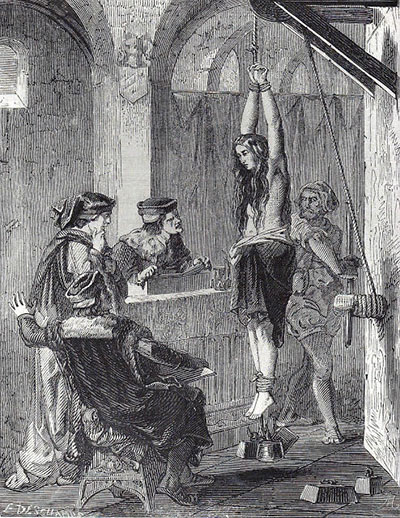 |
| (19th century woodprint of a woman being interrogated for witchcraft) |
(부록)
고문을 견딘 여인
마리아 홀린(Maria Hollin). 56번(혹은 62번)의 고문을 견뎌냄. 여관을 운영하던 홀린은 흑마술을 사용한다는 혐의로 마녀 누명을 쓴다. 홀린 사건 4년 전인 1590년. 그해 뇌르틀링겐에서는 32명의 여성들이 마녀로 몰려 화형 당했다. 그중 한 희생자가 홀린과 함께 언급되곤 하는 레베카 렘프(Rebecca Lemp)다. 악인들은 렘프의 회계사 남편이 출장 간 틈을 이용, 누명을 씌워 잡아갔다. 그녀에게는 6명의 자식들이 있었다! 렘프의 이름이 자주 언급되는 이유가 있다. 그녀가 자식들, 남편과 주고받은 편지들 때문일 것이다. 그녀가 남편에게 쓴 편지의 한 구절은 이렇다. “Alas, alas, my poor children are orphans.” 렘프는 5차례 고문 끝에 자신이 마녀임을 인정, 가족이 지켜보는 가운데 화형을 당한다.
홀린에게 사용한 고문도구들
Maria Hollin, actually held out during fifty-six sessions of torture, which included thumbscrews, legscrews, and the strappado.
 |
| (왼쪽부터 thumbscrews, legscrews, and the strappado.) |
뇌르틀링겐
Nördlingen. 바이에른 자유주 슈바벤 현 도나우리스 군에 소재한 소읍. 898년부터 역사에 기록되기 시작했다.
고문기술자
대개 사형집행관이 고문기술자를 겸했다. 놈들은 취미로 사람 죽이고 고문 한 게 아니다. 돈 받고 그 악행을 저질렀다.
그날은 절대로.....
그날은 절대로 쉽게 오지 않는다. 그날은 깨지고 박살 나 온몸이 너덜너덜해진 다음에 온다. 그날은 참고 기다리면서 엉덩이가 짓물러진 다음에 온다. 그날은 그날을 고대하는 마음과 마음들이 뒤섞이고 걸러지고 나눠지고 침전되고 정리된 이후에 온다. (시인 안도현)
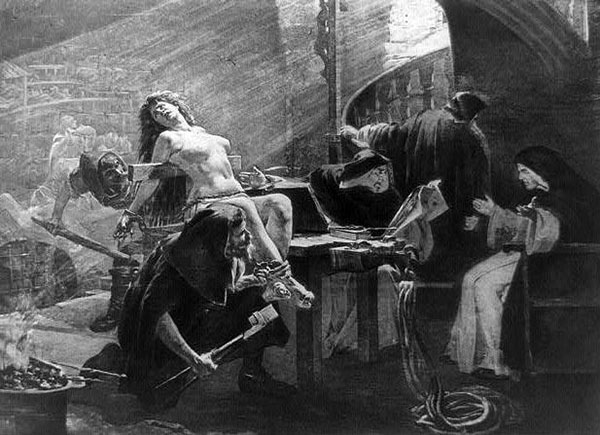 |
더 알고싶으신 분?
In the last decade of the 16th century, a respectable woman who owned a tavern along with her husband in Nördlingen, Germany, was put under arrest by the authority of the town council on suspicion of witchcraft. At first, Holl was patient with the council and their questioners; she was confident that she would be released without much of a hassel. Unfortunately for Maria Holl, the council, inquisitors and the citizens of Nördlingen all believed that she was truly a witch.
With their supposed witch in custody, Holl’s questioners quickly launched into their investigations. First, they stripped their prisoner and searched every space of her body for any abnormalities, skin tags, moles or bumps, which they believed could be ‘witch marks.’ To be thorough, Maria Holl was shaved of all of her body hair, and when a suspected mark was found, it was prodded with a needle, but was not declared a mark of witchcraft. The interrogators concluded that there were no ‘witch marks’ on Holl’s body, but even so, the investigation was just getting under way.
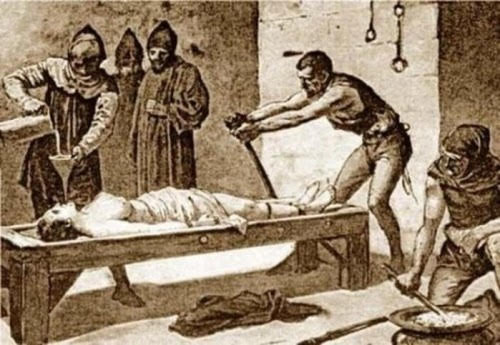 |
With her body examined, the interrogators moved on to her mind. Their first line of questioning attempted to connect Maria Holl with the devil. Had she made a pact with the devil? Had she brought a curse on any of her fellow citizens? Had the devil seduced her? By this point, after having her naked body prodded by needles, and insinuation of adultery with the devil thrown her way by her questioners, Maria Holl abruptly ended her compliance with the interrogators—she refused to make any statements that could lead to self-incrimination.
With no diabolical blemishes on her body, and no semblance of a freely-spoken confession in sight, the interrogators called for torture to begin. The successive sessions of various torture techniques used by the interrogators lasted multiple months. There is little specific information on which torture devices were used, but the strappado (she was hung by her arms with a rope), thumbscrews and the Spanish boot (a device that compressed the leg, sometimes with spikes) were likely used. The rack and the age-old whip were also frequently used in the interrogation of witches in Nördlingen, Germany. Nevertheless, after 62 sessions of torture, possibly lasting a year, Maria Holl still refused to confess to witchcraft. Her steadfast proclamation of innocence, despite months of excruciating pain, finally began to impress the citizens of Nördlingen.
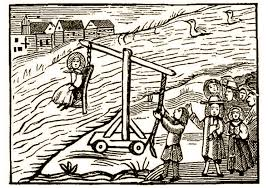 |
The more Maria Holl resisted torture, the more the people of her town began to believe in her innocence. As the population began to support Holl, they also increasingly lost faith in the judgment of the town council and the witch-hunt it was waging against the city. With no confession of witchcraft to justify an execution, the council grudgingly put an end to the torture of Maria Holl. At this point, Holl was not set free. No, the council needed to plan how to defend itself.
The council finally agreed on a plan that would deliver Maria Holl from their dungeon, while also saving their own skins. Holl would be set free, they declared, if and only if she signed a legal form, in which she swore that she would never seek reprisal through a judicial court. For added protection, she had to publicly claim that the town council had acted justly and properly during her trial for witchcraft. Even though Maria Holl received no justice for her abuse at the hands of the Nördlingen inquisitors, she did walk away with her life, and hers was the last case of witchcraft tried in Nördlingen, Germany.
관리자 freemediaf@gmail.com
